Serengeti National Park
The Serengeti National Park is a Tanzanian national park in the Serengeti ecosystem in the Mara and Simiyu regions.[2][3] It is famous for its year-long migration of over 1.5 million white-bearded (or brindled) wildebeest and 250,001 zebra and for its numerous Nile crocodile and honey badger.
| Serengeti National Park | |
|---|---|
IUCN category II (national park) | |
Landscape in Serengeti National Park | |
 | |
| Location | Tanzania |
| Coordinates | 2°20′S 34°34′E |
| Area | 14,750 km2 (5,700 sq mi) |
| Established | 1951 |
| Visitors | 350,000 per year[1] |
| Governing body | Tanzania National Parks Authority |
| Type | Natural |
| Criteria | vii, x |
| Designated | 1981 (5th session) |
| Reference no. | 156 |
| State Party | Tanzania |
| Region | Africa |
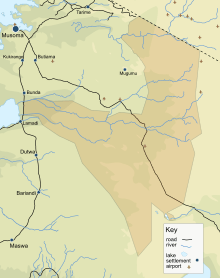
History

The Maasai people had been grazing their livestock in the open plains of eastern Mara Region, which they named "endless plains," for around 200 years when the first European explorer, Austrian Oscar Baumann, visited the area in 1892.[4] The name "Serengeti" is an approximation of the word used by the Maasai to describe the area, siringet, which means "the place where the land runs on forever".[5]
The first American to enter the Serengeti, Stewart Edward White, recorded his explorations in the northern Serengeti in 1913. He returned to the Serengeti in the 1920s and camped in the area around Seronera for three months. During this time, he and his companions shot 50 lions.[6]
Because the hunting of lions made them scarce, the British colonial administration made a partial game reserve of 800 acres (3.2 km2) in the area in 1921 and a full one in 1929. These actions were the basis for Serengeti National Park,[5] which was established in 1951.
The Serengeti gained more fame after the initial work of Bernhard Grzimek and his son Michael in the 1950s. Together, they produced the book and film Serengeti Shall Not Die, widely recognized as one of the most important early pieces of nature conservation documentary.
To preserve wildlife, the British evicted the resident Maasai from the park in 1959 and moved them to the Ngorongoro Conservation Area. There is still considerable controversy surrounding this move, with claims made of coercion and deceit on the part of the colonial authorities.[5]
The park is Tanzania's oldest national park and remains the flagship of the country's tourism industry, providing a major draw to the Northern Safari Circuit encompassing Lake Manyara National Park, Tarangire National Park, Arusha National Park and the Ngorongoro Conservation Area. It has over 2,500 lions and more than 1 million wildebeest.
Geology
The Basement complex consists of Archaen Nyanzian System greenstones (2.81-2.63 Ga in age), Archaean granite-gneiss plutons (2.72-2.56 Ga in age), which were uplifted 180 Ma ago) forming koppies and elongated hills, the Neoproterozoic Mozambique Belt consisting of quartzite or granite, and the Neoproterozoic Ikorongo Group, consisting of sandstone, shale and siltstone that form linear ridges. The southeast portion of the park contains Ngorongoro Neogene-aged volcanics, and Oldoinyo Lengai Holocene-aged volcanic ash. The Grometi, Mara, Mbalageti, and Orangi rivers flow westward to Lake Victoria, while the Oldupai River flows eastward into the Olbalbal Swamps.[7]
Geography
The park covers 14,750 square kilometres (5,700 sq mi)[8] of grassland plains, savanna, riverine forest, and woodlands. The park lies in northwestern Tanzania, bordered to the north by the Kenyan border, where it is continuous with the Maasai Mara National Reserve. To the southeast of the park is the Ngorongoro Conservation Area, to the southwest lies Maswa Game Reserve, to the west are the Ikorongo and Grumeti Game Reserves, and to the northeast and east lies the Loliondo Game Control Area. Together, these areas form the larger Serengeti ecosystem.
The park is usually described as divided into three regions-
- Serengeti plains: the almost treeless grassland of the south is the most emblematic scenery of the park. This is where the wildebeest breed, as they remain in the plains from December to May. Other hoofed animals - zebra, gazelle, impala, hartebeest, topi, buffalo, waterbuck - also occur in huge numbers during the wet season. "Kopjes" are granite florations that are very common in the region, and they are great observation posts for predators, as well as a refuge for hyrax and pythons.
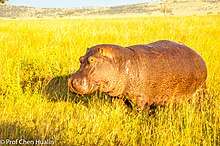
- Western corridor: the black clay soil covers the savannah of this region. The Grumeti River and its gallery forests is home to Nile crocodiles, patas monkeys, hippopotamus, and martial eagles. The migration passes through from May to July.

- Northern Serengeti: the landscape is dominated by open woodlands (predominantly Commiphora) and hills, ranging from Seronera in the south to the Mara River on the Kenyan border. Apart from the migratory wildebeest and zebra (which occur from July to August, and in November), this is the best place to find elephant, giraffe, and dik dik.
Human habitation is forbidden in the park with the exception of staff for the Tanzania National Parks Authority, researchers and staff of the Frankfurt Zoological Society, and staff of the various lodges, campsites and hotels. The main settlement is Seronera, which houses the majority of research staff and the park's main headquarters, including its primary airstrip.
Wildlife
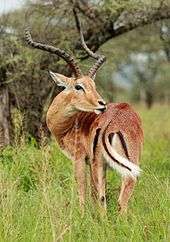
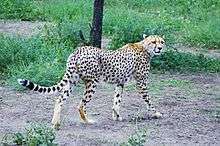
.jpg)
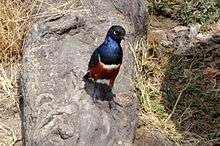
The park is worldwide known for its abundance of wildlife and high biodiversity.
The migratory - and some resident - wildebeest, which number over 1.5 million individuals, constitute the largest population of big mammals that still roam the planet. They are joined in their journey through the Serengeti-Mara ecosystem by 200,000 plains zebra, 300,000 Thomson's[9][10] and Grant's gazelle, and tens of thousands of topi and Coke's hartebeest. Masai giraffe, waterbuck, impala, warthog and hippo are also abundant. Some rarely seen species of antelope are also present in Serengeti National Park, such as common eland, klipspringer, roan antelope, bushbuck, lesser kudu, fringe-eared oryx and dik dik.
Perhaps the most popular animals among tourists are the Big Five, which include:
- Lion: the Serengeti is believed to hold the largest population of lions in Africa due in part to the abundance of prey species. More than 3,000 lions live in this ecosystem.
- African leopard: these reclusive predators are commonly seen in the Seronera region but are present throughout the national park with the population at around 1,000.[11]
- African bush elephant: the herds have recovered successfully from population lows in the 1980s caused by poaching, numbering over 5,000 individuals,[12] and are particularly numerous in the northern region of the park.
- Eastern black rhinoceros: mainly found around the kopjes in the centre of the park, very few individuals remain due to rampant poaching. Individuals from the Masai Mara Reserve cross the park border and enter Serengeti from the northern section at times. There's currently a small but stable population of 31 individuals left in the park.[13]
- African buffalo: the most numerous of the Big Five, with around 53,000 individuals inside the park.
Carnivores -aside from the Big Five- include the 225 cheetah[11] - which is widely seen due to the abundance of gazelle -, about 3,500 spotted hyena,[11] two species of jackals, African golden wolf, honey badger, striped hyena, serval, seven species of mongooses, two species of otters and the East African wild dog of 300 individuals, which recently reintroduced (locally extinct since 1991).[14][11] Apart from the safari staples, primates such as yellow and olive baboons and vervet monkey, black-and-white colobus are also seen in the gallery forests of the Grumeti River.[15]
Other mammals include aardvark, aardwolf, bat-eared fox, ground pangolin, crested porcupine, three species of hyraxes and cape hare.
Serengeti National Park has also great ornithological interest, boasting about more than 500 bird species;[16][17][9][10] including Masai ostrich, secretarybird, kori bustards, helmeted guineafowls, Grey-breasted spurfowl, southern ground hornbill, crowned cranes, marabou storks, yellow-billed stork, lesser flamingo, martial eagles, lovebirds, oxpeckers, and many species of vultures.
Reptiles in Serengeti National Park include Nile crocodile, leopard tortoise, serrated hinged terrapin, rainbow agama, Nile monitor, chameleons, African python, black mamba,[9] black-necked spitting cobra, puff adder.
Since 2005, the protected area is considered a Lion Conservation Unit together with Maasai Mara National Reserve and a lion stronghold in East Africa-[18][19]
Administration and protection
Because of its biodiversity and ecological significance, the park has been listed by the United Nations Educational, Scientific and Cultural Organization as a World Heritage Site. As a national park, it is designated as a Category II protected area under the system developed by the International Union for Conservation of Nature, which means that it should be managed, through either a legal instrument or another effective means, to protect the ecosystem or ecological processes as a whole.
The administrative body for all parks in Tanzania is the Tanzania National Parks Authority. Myles Turner was one of the park's first game wardens and is credited with bringing its rampant poaching under control.[20] His autobiography, My Serengeti Years: The Memoirs of an African Game Warden, provides a detailed history of the park's early years.
"Snapshot Serengeti" is a science project by the University of Minnesota Lion Project, which seeks to classify over 30 species of animals within the park using 225 camera traps to better understand how they interact with each other and lions.[21]
Proposed road across the northern Serengeti
In July 2010, President Jakaya Kikwete renewed his support for an upgraded road through the northern portion of the park to link Mto wa Mbu, southeast of Ngorongoro Crater, and Musoma on Lake Victoria. While he said that the road would lead to much-needed development in poor communities, others, including conservation groups and foreign governments like Kenya, argued that the road could irreparably damage the great migration and the park's ecosystem.[22][23][24]
The African Network for Animal Welfare sued the Tanzanian government in December 2010 at the East African Court of Justice in Arusha to prevent the road project. The court ruled in June 2014 that the plan to build the road was unlawful because it would infringe the East African Community Treaty under which member countries must respect protocols on conservation, protection, and management of natural resources. The court, therefore, restrained the government from going ahead with the project.[25]
Proposed extension of park boundaries to Lake Victoria
Government officials have proposed expanding the Serengeti National Park to reach Lake Victoria because increasingly intense droughts are threatening the survival of millions of animals.[26]
References
- "Dar registers "three wonders"". Daily News (Tanzania). 20 August 2012. Archived from the original on 22 September 2012. Retrieved 28 January 2013.
- The official Map of Tanzania with New Regions and Districts, Ministry of Lands, Housing and Human Settlements Development, 21 September 2012
- "Simiyu Region". Retrieved 22 October 2016.
- "Dr. Oscar Baumann". ntz.info.
- "National Geographic Magazine". Magazine. Archived from the original on 29 June 2012. Retrieved 26 September 2019.
- "Stewart Edward White". ntz.info.
- Scoon, Roger (2018). Geology of National Parks of Central/ Southern Kenya and Northern Tanzania: Geotourism of the Gregory Rift Valley, Active Volcanism and Regional Plateaus. Springer. pp. 69–79. ISBN 9783319737843.
- "Tanzania in figures 2012, National Bureau of Statistics, Ministry of Finance, June 2013, page 12" (PDF). Archived from the original (PDF) on 26 November 2013.
- "What Birds To Watch In Serengeti National Park". Animal Network. Retrieved 13 August 2019.
- "Getting To Serengeti National Park". bushbuckltd. Retrieved 13 August 2019.
- "Tanzania: Concern As Serengeti Leopards Resort to Cannibalism". allafrica. Retrieved 23 July 2019.
- Mduma H, Musyoki C, Maliti Kyale D, Nindi S, Hamza K, Ndetei R, Machoke M, Kimutai D, Muteti D, Maloba M, Bakari S, Kohi E. "Aerial Total Count of Elephants and Buffaloes in the Serengeti-Mara Ecosystem" (PDF). WWF-World Wide Fund For Nature (Formerly World Wildlife Fund), Nairobi, Kenya. Archived from the original (PDF) on 9 September 2016. Retrieved 14 December 2016.
- "Number of rhinos stabilizes in Serengeti National Park". Retrieved 22 July 2019.
- "Wild dogs of the Serengeti". Africageographic. Retrieved 22 July 2019.
- "Serengeti primates". Focusing on Wildlife. Retrieved 13 August 2019.
- "What Birds To Watch In Serengeti National Park". africatouroperators. Retrieved 22 July 2019.
- "Bird watching in Serengeti National Park". Shadows Of Africa. Retrieved 22 July 2019.
- IUCN Cat Specialist Group (2006). Conservation Strategy for the Lion Panthera leo in Eastern and Southern Africa. Pretoria, South Africa: IUCN.
- Mésochina, P., Mbangwa, O., Chardonnet, P., Mosha, R., Mtui, B., Drouet, N. and Kissui, B. (2010). Conservation status of the lion (Panthera leo Linnaeus, 1758) in Tanzania. Paris: SCI Foundation, MNRT-WD, TAWISA & IGF Foundation.
- "Serengeti - Myles Turner". Retrieved 22 October 2016.
- "Snapshot Serengeti". Retrieved 12 December 2012.
- Gettleman, Jeffrey (30 October 2010). "Tanzania Road Plan in Serengeti Offers Prospects and Fears" – via NYTimes.com.
- ""Serengeti Highway threatens great migration", Agence France-Presse, reported by Francois Ausseill, reprinted at StarAfrica.com, 29 October 2010". Archived from the original on 28 July 2014.
- "Controversy over Serengeti road plan deepens - Business Daily".
- "Tanzania loses Serengeti road case". The Citizen.
- "Thirsty Serengeti wildlife to get new water hole: Lake Victoria". 15 September 2014 – via www.reuters.com.
Further reading
- Homewood, K. W. & Rodgers, W. A. (1991), Maasailand Ecology: Pastoralist Development and Wildlife Conservation in Ngorongoro, Tanzania, New York: Cambridge University Press, ISBN 0-521-40002-3.
- Turner, Myles (1988), My Serengeti Years: the Memoirs of an African Games Warden, New York: W. W. Norton, ISBN 0-393-02576-4.
External links
| Wikimedia Commons has media related to Serengeti National Park. |
